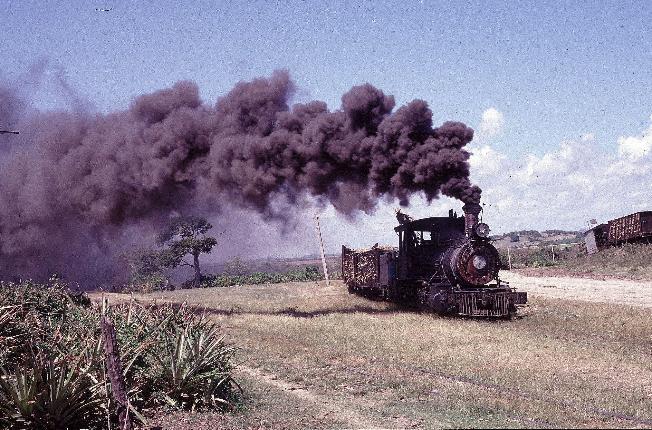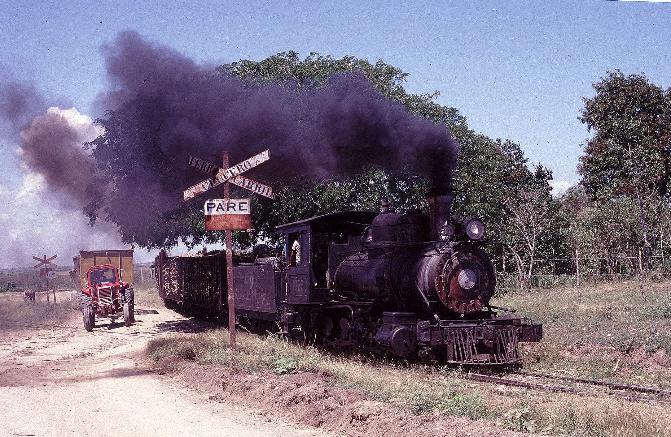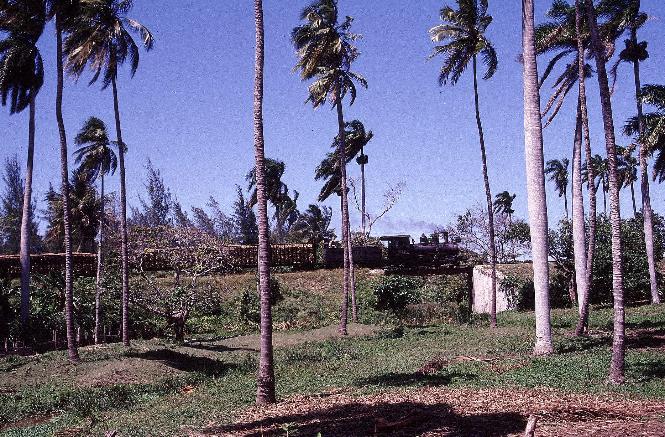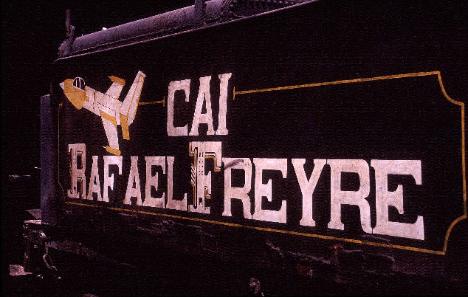

| RAFAEL FREYRE PURIAL BRANCH AND MILL |
This branch ran for approximately 16km in a westerly direction from the mill to the loading point at Purial. There were also
several intermediate loading points along the route. In general terms there was less cane to be collected along this line and
also the task was shared with an increasing number of lorries and so trains were less common than on the longer Uvilla line.
several intermediate loading points along the route. In general terms there was less cane to be collected along this line and
also the task was shared with an increasing number of lorries and so trains were less common than on the longer Uvilla line.

| Find a train and stick with it' was always a wise policy. As with any industrial system the trains did not operate to a strict timetable (although distinct patterns of working were discernible) and fruitless hours could be spent chasing distant smoke which never seemed to get any closer! Baldwin 2-8-0 No.1389 (built 1912) has arrived at Purial and is taking water from the local stream using a pump on the tender (28 March 1997) |

| Side on view of No.1389 at Purial. Unlike a number of ther Rafael Freyre engines No.1389 did not sport any artwork on the tender - just the Central Rafael Freyre legend (see below) |

Baldwin 2-8-0 No 1389 lifting a
loaded train away from Purial.
Lineside photography is strewn with
possible pitfalls - in this case an
approaching lorry and a large dust
cloud are just too late to spoil the shot
although the smoke blowing over the
engine presents its own problems
loaded train away from Purial.
Lineside photography is strewn with
possible pitfalls - in this case an
approaching lorry and a large dust
cloud are just too late to spoil the shot
although the smoke blowing over the
engine presents its own problems

Chasing the train by car was a popular
activity amongst visiting photographers.
Most trains actually travelled quite
slowly, with stops at loading points en
route, allowing multiple shots of the same
train. However upsetting the locals by
racing through villages was not advisable
and was also very dangerous. Those who
were foolish enough to do so have been
known to return to their car to find all
the tyres let down!
No.1389 approaches Potrerillo en route
to the mill
activity amongst visiting photographers.
Most trains actually travelled quite
slowly, with stops at loading points en
route, allowing multiple shots of the same
train. However upsetting the locals by
racing through villages was not advisable
and was also very dangerous. Those who
were foolish enough to do so have been
known to return to their car to find all
the tyres let down!
No.1389 approaches Potrerillo en route
to the mill

One of muy personal favourites - it
seems to capture the rural nature
of the Cuban sugar lines - unmade
roads, unguarded crossings and the
dated Russian tractors - with
No.1389 making its way to Rafael
Freyre
seems to capture the rural nature
of the Cuban sugar lines - unmade
roads, unguarded crossings and the
dated Russian tractors - with
No.1389 making its way to Rafael
Freyre

The lightly laid tracks and a fairly
lacklustre approach to maintaining
the permanent way meant that
derailments were commonplace -
leading to some interesting
techniques for rerailing! Note the 'air
gap' between the wheels of the crane
lorry and terra firma!
lacklustre approach to maintaining
the permanent way meant that
derailments were commonplace -
leading to some interesting
techniques for rerailing! Note the 'air
gap' between the wheels of the crane
lorry and terra firma!


With the line blockage cleared
No.1389 continues on its journey,
crossing a small bridge between
Potrerillo and La Mango
No.1389 continues on its journey,
crossing a small bridge between
Potrerillo and La Mango
No.1389 approaching La Mango
seen through a grove of palm trees -
a real rural idyll.
seen through a grove of palm trees -
a real rural idyll.

With a few exceptions, entry into mill
yards and engine sheds was fairly
easy. Here Baldwin 2-8-0 No.1388
(built 1907) is being prepared to
leave the mill and head off towards
Uvilla. Identification of locomotives
seen from a distance was greatly
aided by the individual pictures that
were painted onto the sides of the
tender - in this case a mythical flying
horse
yards and engine sheds was fairly
easy. Here Baldwin 2-8-0 No.1388
(built 1907) is being prepared to
leave the mill and head off towards
Uvilla. Identification of locomotives
seen from a distance was greatly
aided by the individual pictures that
were painted onto the sides of the
tender - in this case a mythical flying
horse


Some further examples of the painting of logos on the sides of the tenders which was unique to Rafael Freyre. Baldwin
No.1390 sported a marlin, No.1386 had a camel, No. 1388 had a rabbit (above right) and No. 1391 had this artists impression
of MIG fighter! (above left)
No.1390 sported a marlin, No.1386 had a camel, No. 1388 had a rabbit (above right) and No. 1391 had this artists impression
of MIG fighter! (above left)

In addition to a fleet of eight Baldwin 2-8-0's, there
were also a Baldwin 0-6-0 which were mainly
confined to the shed but occasionally made available
for use in return for a sum of money from visiting
enthusiasts. This is No.1180 (Rafael Freyre No.1)
built in 1882 and seen inside the shed in 1997.
The end of steam and indeed of sugar cane
production came just after the start of the new
century. Little or no production in 2001 led to the
engines being out of use and the mill's inactivity during
2001 impacted greatly on the system's performance
during 2002. Five 5 steam locos received attention
during June 2001 and were (with the exception of
those used for the tourist train) mothballed for this
year. But when the harvest started, their lack of use
since the summer of 2000 brought almost daily
failures, even on shortened trains. The most common
problems being bearings running hot and tubes
blowing.
2002 brought further problems - as reported by tour
operators 'Steam In Paradise' - ".. during the first 2
months of the Zafra, if there was loco fuel available,
water supplies could be accessed, telegraph poles did
not fall across the tracks after rain-storms, the loco
did not fail on the outward run with the empties, or
derail at the loading point, there was an outside
chance of getting a chimney first shot on loads before
darkness! " By 2003 the mill was closed and
dismantled and only a tourist train operation was left
- using No.1180 and No.1388. Real steam at Rafael
Freyre was no more!
were also a Baldwin 0-6-0 which were mainly
confined to the shed but occasionally made available
for use in return for a sum of money from visiting
enthusiasts. This is No.1180 (Rafael Freyre No.1)
built in 1882 and seen inside the shed in 1997.
The end of steam and indeed of sugar cane
production came just after the start of the new
century. Little or no production in 2001 led to the
engines being out of use and the mill's inactivity during
2001 impacted greatly on the system's performance
during 2002. Five 5 steam locos received attention
during June 2001 and were (with the exception of
those used for the tourist train) mothballed for this
year. But when the harvest started, their lack of use
since the summer of 2000 brought almost daily
failures, even on shortened trains. The most common
problems being bearings running hot and tubes
blowing.
2002 brought further problems - as reported by tour
operators 'Steam In Paradise' - ".. during the first 2
months of the Zafra, if there was loco fuel available,
water supplies could be accessed, telegraph poles did
not fall across the tracks after rain-storms, the loco
did not fail on the outward run with the empties, or
derail at the loading point, there was an outside
chance of getting a chimney first shot on loads before
darkness! " By 2003 the mill was closed and
dismantled and only a tourist train operation was left
- using No.1180 and No.1388. Real steam at Rafael
Freyre was no more!

The museum line is still in operation
using Baldwin No.1 (or No.1180) to
haul some specially built tourist
coachesand is seen here in 2008 with
the tender now bearing the
pre-revolutionary name of the mill
Central Santa Lucia
My thanks to Martin Bray for this
picture www.margam-depot.co.uk
using Baldwin No.1 (or No.1180) to
haul some specially built tourist
coachesand is seen here in 2008 with
the tender now bearing the
pre-revolutionary name of the mill
Central Santa Lucia
My thanks to Martin Bray for this
picture www.margam-depot.co.uk